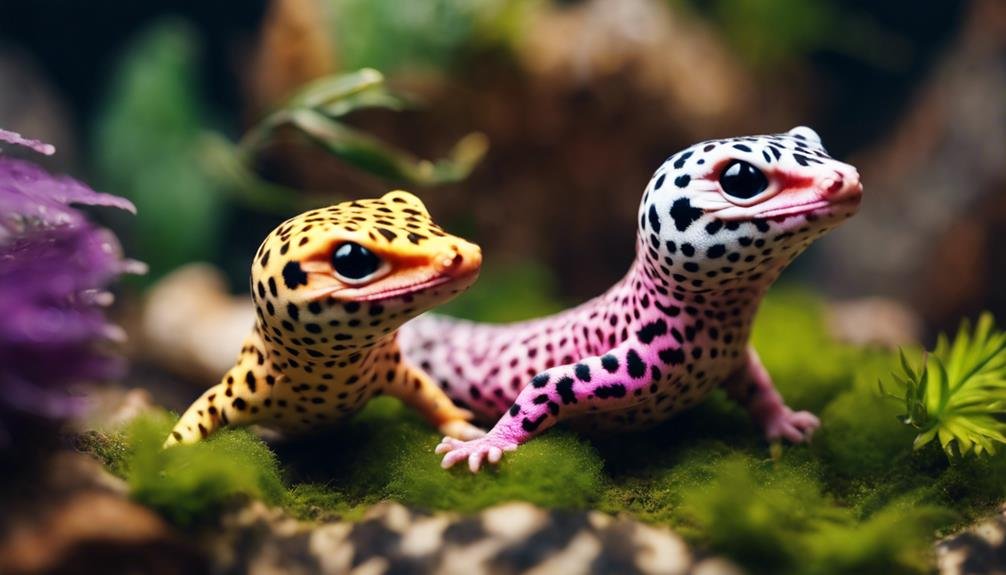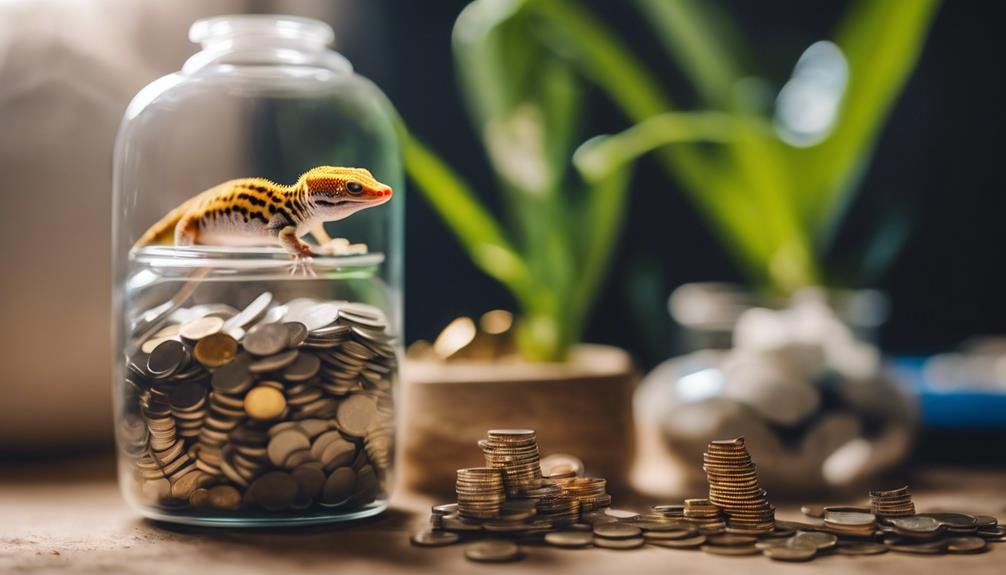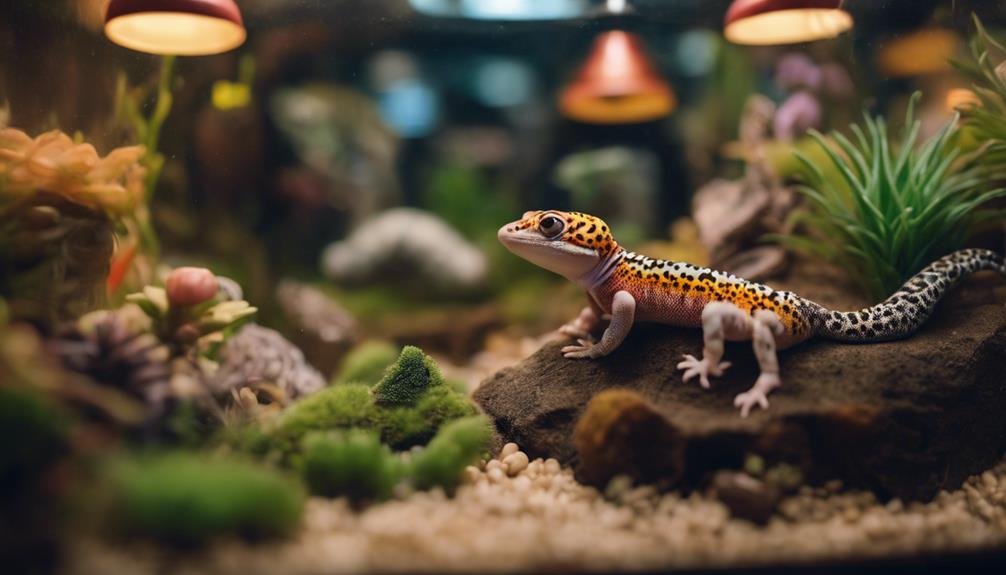You might be considering a leopard gecko as your next pet, and you’re likely wondering how much they cost. While the initial price tag for these unique reptiles can vary greatly based on their morph and the source from which you buy them, it’s the ongoing care that often adds up. Whether you opt for a common morph from a pet store or a rarer variety from a breeder, each choice impacts not only the upfront cost but also the subsequent investment in their habitat and health. Before you make a decision, you’ll want to explore how these factors converge to affect not just your wallet but also the quality of life for your potential new companion.
Key Takeaways
- Leopard geckos from pet stores start at around $20, but prices vary based on morph.
- Breeder leopard geckos range from $40 to several hundred dollars, providing genetic transparency.
- Common morph prices: Albino ($34.95), Regular ($44.95), Super Snow ($149.00).
- Rare morphs like Hypo Tangerine Carrot Tail can cost up to $149.00.
- Ongoing care expenses for leopard geckos typically range from $250 to $300 annually.
Initial Purchase Prices
The initial purchase price for a leopard gecko can range from as low as $34.95 for an Albino morph to up to $149.00 for specialty morphs like Super Snow. When you’re exploring the world of pet reptiles, understanding these initial purchase prices is important. Regular leopard geckos might catch your eye at $44.95, especially when they’re on sale.
However, if you’re drawn to something a bit more unique, the Pinstripe and Super Snow varieties are priced between $49.95 and $149.00, offering striking patterns that stand out in a terrarium.
Diving deeper into the world of rarity, the Aptor and Raptor morphs are tagged between $69.95 and $79.00. These prices reflect their less common appearances in the pet market. It’s also worth noting that some high-demand morphs, like the Hypo Tangerine Carrot Tail, are often sold out due to their popularity and distinctiveness, which can affect availability and price.
As you set out to choose your new pet, remember that pet reptiles like leopard geckos come in a broad price range. This variety allows you to select a pet that not only meets your aesthetic preferences but also fits your budget.
Breeder Vs Pet Store Costs
When choosing between a breeder and a pet store for your leopard gecko, consider that breeders generally offer healthier, genetically clearer pets at a slightly higher cost. You’ll find that breeder vs pet store costs can vary greatly based on factors like genetic lineage and the breeder’s reputation.
Purchasing from a breeder, you might pay anywhere from $40 to a few hundred dollars, depending on the age and morph of the leopard gecko. This higher price often reflects the breeder’s dedication to health and genetic transparency. Breeders typically provide detailed genetic information and health guarantees, ensuring you’re informed about exactly what you’re getting.
In contrast, pet store leopard geckos may start at a lower price, around $20, but the lower cost can come with risks. These geckos often have uncertain genetic backgrounds and may lack detailed health guarantees. The initial savings could potentially lead to higher veterinary costs down the line due to undisclosed health or genetic issues.
Investing in a gecko from a reputable breeder might cost you more upfront, but it ensures a healthier and genetically sound pet. This choice can save you from future worries and expenses, making it a wise long-term investment.
Rare Morphs Pricing


Exploring rare morphs, you’ll find that pricing varies greatly, starting as low as $34.95 for Mack Snow Leopard Geckos. If you’re eyeing something a bit more unique, like the Albino Leucistic Leopard Geckos, they’re just a bit more, priced at $39.95. Similarly, Blazing Blizzard Leopard Geckos, with their distinctive appearance, also start at $39.95.
As you investigate further into the world of these fascinating creatures, you’ll come across Pinstripe Leopard Geckos, slightly pricier at $49.95. However, if you’re looking for a standout, the Hypo Tangerine Carrot Tail Leopard Geckos, which were available for $149.00, are currently sold out. This indicates their high demand and rarity.
Each of these morphs, whether it’s the Snow Leopard or the Albino Leopard, offers a unique aesthetic that can vary significantly in both appearance and price. As you consider which Leopard Gecko to bring into your home, it’s clear that the rarer the morph, the higher the price tag might be. But remember, what you’re paying for isn’t just a pet; it’s a truly distinctive companion, each with its own set of striking features and colors.
Ongoing Care Expenses
Caring for your leopard gecko involves ongoing expenses that you’ll need to take into account, including costs for food, habitat maintenance, and healthcare. While the initial setup is a one-time cost, the day-to-day upkeep is where you’ll notice your budget stretching.
Here’s a quick breakdown of typical ongoing care expenses for leopard geckos:
- Feeder Insects and Supplements: Expect to spend around $16 per month on insects like crickets and mealworms, along with necessary calcium and vitamin supplements.
- Heating and Lighting: Equipment costs, including bulbs and thermostats, can range from $50 to $100. These are essential for maintaining the right environment.
- Substrate and Decorations: Costs vary widely here, from as little as $10 for simple paper towels to over $65 for more naturalistic setups like slate.
- Veterinary Care: Routine check-ups and treatments can cost between $100 and $200, with more complex issues like surgeries going over $500.
It’s important to budget wisely and consider these ongoing care expenses to ensure your leopard gecko stays healthy and happy. By planning ahead, you can manage costs more effectively and avoid surprises down the road.
What is the Price Difference Between Leopard Geckos and Chameleons?
When comparing the chameleon cost and pricing to leopard geckos, leopard geckos are generally more affordable. While chameleons can range from $30 to $400, leopard geckos are typically priced between $20 to $100. However, factors such as morph, age, and breeding can influence the cost of both reptiles.
Additional Ownership Costs


Beyond the initial setup and routine care, you’ll also encounter additional costs related to enhancing and maintaining your leopard gecko’s habitat. Upgrading the tank with new decor or better habitat features can set you back $15 to $30 for each item. It’s not just about making the tank look good; these enhancements can also help mimic the natural environment of leopard geckos, promoting better health and behavior.
Speaking of health, don’t forget to budget for veterinary care. Regular check-ups are important, though many overlook this aspect of pet care. Setting aside an emergency fund is also wise, as unexpected health issues aren’t rare and can be costly.
Yearly expenses, including feeding, substrate replacement, and equipment updates, typically range between $250 to $300. However, if you’re up for a bit of DIY, growing your own feeder insects could drastically cut down these costs to about $100 annually. Remember, being financially prepared isn’t just about covering the basics but ensuring you can afford these additional expenses without strain. This approach not only safeguards your pet’s well-being but also keeps you from unexpected financial stress.
Conclusion
To sum up, if you’re considering a leopard gecko, you’ll find initial prices ranging from $20 at pet stores to $149 for rare morphs. Opting for a breeder might cost a bit more, starting at $40, but you’ll benefit from knowing the gecko’s genetic history and health.
Remember, the purchase price is just the beginning. You’ll also need to budget for yearly care expenses, which can average between $250 and $300, covering everything from feeding to vet visits.


